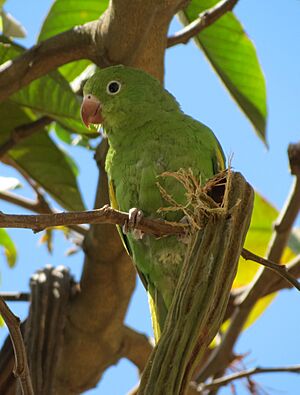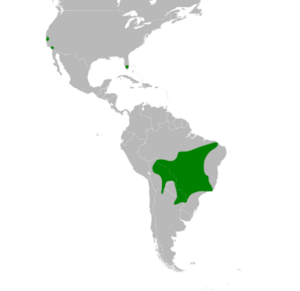Yellow-chevroned parakeet facts for kids
Quick facts for kids Yellow-chevroned parakeet |
|
|---|---|
 |
|
| In Belo Horizonte, Brazil. | |
| Conservation status | |
| Scientific classification | |
| Genus: |
Brotogeris
|
| Species: |
chiriri
|
 |
|
The yellow-chevroned parakeet (Brotogeris chiriri) is a bright green bird. It lives in warm parts of South America, south of the Amazon River. You can find it in central Brazil, southern Bolivia, Paraguay, and northern Argentina. Sometimes, pet parakeets escape or are set free. These birds have started new groups in places like Miami, Florida, and Los Angeles and San Francisco, California. They are also found in cities like Rio de Janeiro, Brazil, and Buenos Aires, Argentina. The wild parakeet groups in South America are still doing very well.
Contents
About the Yellow-Chevroned Parakeet
This parakeet is about 20 to 25 centimeters (8 to 10 inches) long. It is mostly a light green color. When it flies or rests, you can see a yellow edge on its wings. This yellow edge looks like a "chevron" or a V-shape. Until 1997, people thought this bird was the same as the white-winged parakeet. Wild yellow-chevroned parakeets usually live in forests that have been disturbed. They also like open areas around towns. They do not often live deep inside thick tropical forests.
What Yellow-Chevroned Parakeets Eat
In their natural home, these parakeets mainly eat seeds and fruit. Parakeets that live in new places, like cities, have learned to eat blossoms and nectar. When it is dry and there is not much fruit, they eat more seeds. They especially like seeds from the Erythrina dominguezii plant. They also enjoy eating from Bombacaceae trees, also known as silk cotton trees. These trees are a favorite food for the parakeets.
Sometimes, these birds eat soil, especially from places with clay. This is called geophagia. Parakeets in cities also visit bird feeders for food. Yellow-chevroned parakeets also eat parts of termite nests that are built in trees. These nests are made of clay and other natural materials. Eating these nests seems to give the birds important nutrients. These nutrients include things like potassium, magnesium, and aluminum. These might help the female birds when they are forming eggs.
Reproduction and Life Cycle
Yellow-chevroned parakeets usually make their nests in holes they find in trees. They can also dig tunnels for their nests in dead palm leaves. The female parakeet usually lays four to five eggs. After the young birds grow up, all the parakeets gather together. They form large groups where they sleep until it is time to breed again.
Images for kids








